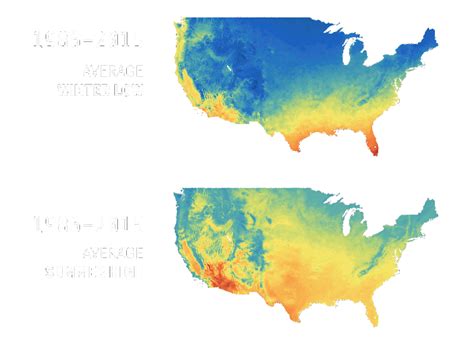With global warming already having a detrimental effect on the environment, it is no surprise that one of the burning questions on the lips of many people is, ‘How hot will the US be in 2050?’. With temperatures in the US already rising faster than the global average, it is vital to consider the potential impacts this could have on our environment.
The answer to this question is not a simple one. However, research has indicated that the average temperature in the US could rise by up to 4 degrees by 2050. This might not seem like a large increase, but it would have a significant impact on various areas of the US. For example, the amount of droughts, floods, and intensity of hurricanes are likely to increase.
It is also expected that temperatures in the western US will increase more significantly than those in the east. For this region, it is predicted that temperatures could rise by up to 6 degrees by 2050. This could potentially cause a rapid decline in the quality of air and water in this region.
Furthermore, it is expected that the US will experience more extreme weather conditions. This could include heat waves, as well as more frequent and intense hurricanes, droughts, and floods. This could have a large impact on wildlife, as well as humans, who may be forced to relocate due to the extreme weather conditions.
It is also important to consider the long-term effects of the rising temperatures. For example, sea levels are predicted to rise by between 0.3 and 0.5 meters by 2050. This could have a dramatic effect on coastal areas, which could be significantly impacted by increased flooding.
Overall, it is clear that the US could experience dramatic changes in its climate by 2050. Temperatures are expected to increase, causing more extreme weather conditions, as well as an increase in sea levels. All of these changes could have a significant impact on the environment, as well as humans. Therefore, it is vital to take action now to try to reduce carbon emissions to try to minimize the potential effects of climate change.
Climate Change: How Hot Will the US Be in 2050?
Climate Change is a pressing issue that has been affecting the world for decades, and it will continue to do so in the future. In the US, specifically, the current climate is predicted to change drastically within the next thirty years. This article will go over how hot the US will be in 2050.
One of the most significant predictions is that the average temperature in the US will rise between 3-5 degrees Fahrenheit by 2050. This means that some parts of the US will be up to 12 degrees warmer than they are now. Also, some areas of the US will see a decrease in rainfall.
Another prediction is that extreme weather events will become more common, and they will be more expensive. The occurrence of floods, hurricanes, and tornadoes will be more regular, and they will cause more damage than in the past. This means that there will be an increased risk to life and property.
The effects of a hotter US will be far-reaching. There will be an increase in the number of heat-related deaths, and there will also be an increase in the risk of water shortages. In addition, some crops and plants may not be able to grow in the new warmer environment, leading to a decrease in food production.
Overall, Climate Change is a real threat and it will have a large impact on the US by 2050. It is estimated that the average temperature in the US will rise between 3-5 degrees Fahrenheit, and there will also be an increase in extreme weather events. These changes will lead to an increase in the number of heat-related deaths, as well as an increased risk of water shortages. Additionally, some crops and plants may not be able to grow in the new warmer environment, leading to a decrease in food production.
To reduce the effects of Climate Change, it is important to take action now. This includes reducing emissions from transportation, power plants, and industry, and increasing the use of renewable energy sources. Additionally, conserving water and planting trees can help reduce the effects of Climate Change.
The Impact of Increasing Temperatures on the US in 2050
The US is expected to face drastic temperature increases as we move into 2050. The impacts of this increasing heat will be felt in a number of ways, from agriculture to industry to energy use.
According to the Intergovernmental Panel on Climate Change (IPCC), the average temperature in the US is expected to increase by up to 6°F by 2050. This could result in more frequent heat waves, droughts, and floods, which could have significant negative impacts on urban populations, agriculture, energy production, and the economy at large.
Higher temperatures will reduce crop yields in the US. Warmer temperatures will increase the risk of crop diseases and pest infestations, while more extreme weather events, such as floods and droughts, will negatively affect crop yields and food security. This could have major impacts on the US economy, as food prices will rise and food supply will decrease.
In addition to the impact on agriculture, higher temperatures will also affect other sectors of the economy. The energy sector is particularly vulnerable to climate change, as higher temperatures will increase the demand for cooling and air conditioning. This could lead to an increase in energy costs, as well as increased pressure on the electricity grid.
Higher temperatures will also have negative impacts on the environment. Warmer temperatures can lead to more air pollution, as hot air is more likely to trap pollutants. This can lead to poor air quality and respiratory diseases. Warmer temperatures can also increase the intensity and frequency of extreme weather events, such as hurricanes, floods, and wildfires, which can cause widespread destruction and disruption.
The impact of increasing temperatures on the US in 2050 will be significant. It is important for governments, businesses, and citizens to take action now to reduce emissions and mitigate the effects of climate change.
 Road Topic Tourism & Travel
Road Topic Tourism & Travel




